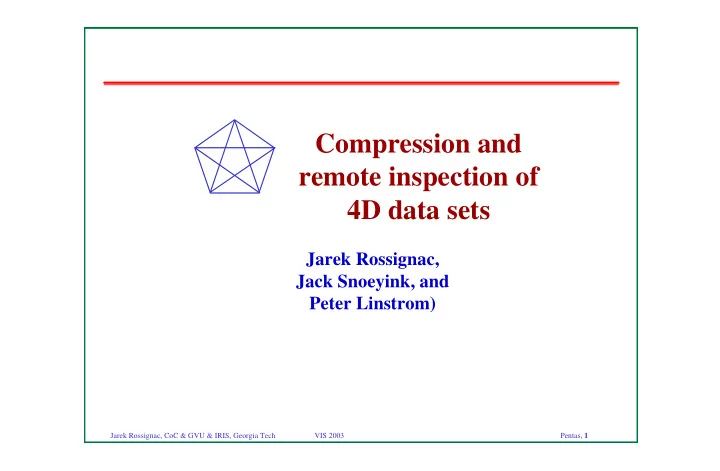

Compression and remote inspection of 4D data sets Jarek Rossignac, Jack Snoeyink, and Peter Linstrom) Jarek Rossignac, CoC & GVU & IRIS, Georgia Tech VIS 2003 Pentas, 1
Simulation results are huge • Computed over a regular 4D grid – 1000 4 (x,y,z,t) samples – Several attributes per sample (pressure, temp…): 5D terrain • Issues and proposed approaches – Storage / transmission : Simplification, Compression, Progressive – Interactive visualization : 2D slice or level-set of hyper-surface in 5D – Decide what to inspect : Control terrain + level-of-interest + mark-up – Access only what is needed: Iso-surface tracking and updating HPPC Storage Selection Visualization Local Server Model 3D Viewing Jarek Rossignac, CoC & GVU & IRIS, Georgia Tech VIS 2003 Pentas, 2
Regular... or not? pentatope in 5D P(x,y,z,t) P(x,y,z,t) (x,y,z) (x,y,z) t t Jarek Rossignac, CoC & GVU & IRIS, Georgia Tech VIS 2003 Pentas, 3
4D Delaunay computation and refinement Ajith Mascarenhas and Jack Snoeyink (UNC) Jarek Rossignac, CoC & GVU & IRIS, Georgia Tech VIS 2003 Pentas, 4
Iso-surfaces from pentatopes • Mesh of 5-simplices are 4d surface in 5d: – Pentatopes (4d) � Slice away 2 dimens – Tetrahedra (3d) – Triangles (2d) to form isosurface: – Faces (2d) – Edges (1d) – Vertices (0d) Jarek Rossignac, CoC & GVU & IRIS, Georgia Tech VIS 2003 Pentas, 5
Yes, this is crazy… • Regular grid stores values only • mesh adds (x,y,z,t) & incidence 2d: Triangle 3d: Tetrahedron 4d: Pentatope Simp/vertex 2 7 28 Words/vertex 15 51 244 • Allows local ref inement, so we try anyway… Jarek Rossignac, CoC & GVU & IRIS, Georgia Tech VIS 2003 Pentas, 6
Incremental 4D Delaunay • Can’t use simplification (full resolution mesh is too large) • Implemented insertion heuristic to build interpolating mesh – Add points with greatest error to 4D Delaunay and retriangulate As expected: Mesh requires large storage space Jarek Rossignac, CoC & GVU & IRIS, Georgia Tech VIS 2003 Pentas, 7
Results • Severe aliasing for sections of low- resoution penta-meshes • Iso-surface from the JetDataChunk data-set at iso-value = 128, time = 12 Iso-surfaces at three stages of refinement vert ices: 16K 45K 72K pent at opes: 0.4M 1.0M 1.7M Jarek Rossignac, CoC & GVU & IRIS, Georgia Tech VIS 2003 Pentas, 8
Tools for remote exploration What tools can we provide to suggest when & where to look in large simulation data sets? Jarek Rossignac, CoC & GVU & IRIS, Georgia Tech VIS 2003 Pentas, 9
Interactive visualization • Time dependent slices: 1000 videos in parallel • Translucent (volumetric) video • Move color coded section through space and time • Color-coded iso-surface: S(p,t) Jarek Rossignac, CoC & GVU & IRIS, Georgia Tech VIS 2003 Pentas, 10
Safari on the (p,t) plane • Samples from pressure p = f (x, y, z, t) . • Level sets defined by two parameters: L(P, T) = { (x, y, z) : P = f (x, y, z, T) } • Partition the data dimensions – Viewing volume (x, y, z) – Control plane (p, t ) Jarek Rossignac, CoC & GVU & IRIS, Georgia Tech VIS 2003 Pentas, 11
Iso-surface compression • Out-of-core compression and simplification of iso-surfaces and geometric models • Jack Snoyink,Martin Isenburg (UNC) • Based on segmentation � Part of a 6GB iso-surface that compresses to 640MB losslessly, & decompresses with a memory footprint of 9MB. Jarek Rossignac, CoC & GVU & IRIS, Georgia Tech VIS 2003 Pentas, 12
Lorenzo Predictor f or the out- of - core compression of 4D data sets Lorenzo Ibarria Peter Lindstrom Jarek Rossignac Lawrence Livermore National Labs Andrzej Szymczak Georgia Tech L. Ibarria, P. Lindstrom, J. Rossignac, A. Szymczak, Out-of-core compression and decompression of large n-dimensional scalar fields, Eurographics 2003.
Focus on huge 4D scalar f ields Input : P(x,y,z,t) sampled on regular 4D grid Quantized P(x,y,z,t) - to desired accuracy Loss-less compression Trivial implementation (x,y,z) Out-of-core codecs t 10/25/2003 Rossignac: Lorenzo 3
Scanline codecs foot-print ˜ 1 slice For t=0 to t max do For z=0 to z max do For y=0 to y max do For x=0 to x max do { Predict P(x,y,z,t) from visited neighbors Encode/decode the correction} 10/25/2003 Rossignac: Lorenzo 4
Lorenzo predict or � Predict P at corner of hypercube from values at the other corners – Set origin at opposite corner � 2D: P(1,1)=P(1,0)+P(0,1)-P(0,0) � 3D: P(1,1,1)= ? a–? b+c � 4D: P(1,1,1,1)= ? n 1 –? n 2 + ? n 3 –n 4 – n i is reachable through i edges – Exact predictor for cubics in 4D 10/25/2003 Rossignac: Lorenzo 5
Result s f or lossless compression � Small memory footprint � Easy to implement � Exactly reconstructs polynomials of degree n–1 � Can outperform wavelets 10/25/2003 Rossignac: Lorenzo 6
How it all will come t oget her � Use Lorenzo predictor to compress data on server for archival and posting � Use contour trees analysis in 4D on server to compute imavge for (p,t) terrain � Use Safari on client to plan, conduct, record, annotate exploration on the (p,t) terrain � Use seed-set on server to quickly extract iso-surface � Use out-of-core compression/simplification to transmit desired iso-surface � Use Lorenzo predictor decompression to download selected portions of the original 4D data for local exploration/analysis 10/25/2003 Rossignac: Lorenzo 7
Recommend
More recommend